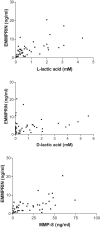Influence of vaginal bacteria and D- and L-lactic acid isomers on vaginal extracellular matrix metalloproteinase inducer: implications for protection against upper genital tract infections
- PMID: 23919998
- PMCID: PMC3735189
- DOI: 10.1128/mBio.00460-13
Influence of vaginal bacteria and D- and L-lactic acid isomers on vaginal extracellular matrix metalloproteinase inducer: implications for protection against upper genital tract infections
Erratum in
- MBio. 2014;5(2):e00874-14. Dosage error in article text
Abstract
We evaluated levels of vaginal extracellular matrix metalloproteinase inducer (EMMPRIN) and matrix metalloproteinase (MMP-8) in vaginal secretions in relation to the composition of vaginal bacterial communities and D- and L-lactic acid levels. The composition of vaginal bacterial communities in 46 women was determined by pyrosequencing the V1 to V3 region of 16S rRNA genes. Lactobacilli were dominant in 71.3% of the women, followed by Gardnerella (17.4%), Streptococcus (8.7%), and Enterococcus (2.2%). Of the lactobacillus-dominated communities, 51.5% were dominated by Lactobacillus crispatus, 36.4% by Lactobacillus iners, and 6.1% each by Lactobacillus gasseri and Lactobacillus jensenii. Concentrations of L-lactic acid were slightly higher in lactobacillus-dominated vaginal samples, but most differences were not statistically significant. D-Lactic acid levels were higher in samples containing L. crispatus than in those with L. iners (P<0.0001) or Gardnerella (P=0.0002). The relative proportion of D-lactic acid in vaginal communities dominated by species of lactobacilli was in concordance with the proportions found in axenic cultures of the various species grown in vitro. Levels of L-lactic acid (P<0.0001) and the ratio of L-lactic acid to D-lactic acid (P=0.0060), but not concentrations of D-lactic acid, were also correlated with EMMPRIN concentrations. Moreover, vaginal concentrations of EMMPRIN and MMP-8 levels were highly correlated (P<0.0001). Taken together, the data suggest the relative proportion of L- to D-lactic acid isomers in the vagina may influence the extent of local EMMPRIN production and subsequent induction of MMP-8. The expression of these proteins may help determine the ability of bacteria to transverse the cervix and initiate upper genital tract infections.
Importance: A large proportion of preterm births (>50%) result from infections caused by bacteria originating in the vagina, which requires that they traverse the cervix. Factors that influence susceptibility to these infections are not well understood; however, there is evidence that matrix metalloproteinase (MMP-8) is known to alter the integrity of the cervix. In this work, we show that concentrations of vaginal extracellular matrix metalloproteinase inducer (EMMPRIN) are influenced by members of the vaginal microbial community and concentrations of D- or L-lactic acid isomers in vaginal secretions. Elevated levels of D-lactic acid and the ratio of D- to L-lactic acid influence EMMPRIN concentrations as well as MMP-8 levels. Thus, isomers of lactic acid may function as signaling molecules that alter host gene expression and influence risk of infection-related preterm birth.
Figures



Similar articles
-
Differential expression of lactic acid isomers, extracellular matrix metalloproteinase inducer, and matrix metalloproteinase-8 in vaginal fluid from women with vaginal disorders.BJOG. 2015 Nov;122(12):1580-5. doi: 10.1111/1471-0528.13072. Epub 2014 Sep 8. BJOG. 2015. PMID: 25196575
-
Vaginal Biomarkers That Predict Cervical Length and Dominant Bacteria in the Vaginal Microbiomes of Pregnant Women.mBio. 2019 Oct 22;10(5):e02242-19. doi: 10.1128/mBio.02242-19. mBio. 2019. PMID: 31641087 Free PMC article.
-
Properties of Epithelial Cells and Vaginal Secretions in Pregnant Women When Lactobacillus crispatus or Lactobacillus iners Dominate the Vaginal Microbiome.Reprod Sci. 2018 Jun;25(6):854-860. doi: 10.1177/1933719117698583. Epub 2017 Mar 17. Reprod Sci. 2018. PMID: 28301987
-
Vaginal microbiome.Ceska Gynekol. 2018 Winter;83(5):371-379. Ceska Gynekol. 2018. PMID: 30848142 Review. English.
-
[Characteristics and physiologic role of female lower genital microbiome].Orv Hetil. 2023 Jun 18;164(24):923-930. doi: 10.1556/650.2023.32791. Print 2023 Jun 18. Orv Hetil. 2023. PMID: 37330978 Review. Hungarian.
Cited by
-
Genital Micro-Organisms in Pregnancy.Front Public Health. 2020 Jun 16;8:225. doi: 10.3389/fpubh.2020.00225. eCollection 2020. Front Public Health. 2020. PMID: 32612969 Free PMC article. Review.
-
The vaginal microbiome during pregnancy and the postpartum period in a European population.Sci Rep. 2015 Mar 11;5:8988. doi: 10.1038/srep08988. Sci Rep. 2015. PMID: 25758319 Free PMC article.
-
Vaginal community state types (CSTs) alter environmental cues and production of the Staphylococcus aureus toxic shock syndrome toxin-1 (TSST-1).J Bacteriol. 2024 Mar 21;206(3):e0044723. doi: 10.1128/jb.00447-23. Epub 2024 Feb 9. J Bacteriol. 2024. PMID: 38334326 Free PMC article.
-
Postbiotics and Their Health Modulatory Biomolecules.Biomolecules. 2022 Nov 4;12(11):1640. doi: 10.3390/biom12111640. Biomolecules. 2022. PMID: 36358990 Free PMC article. Review.
-
Vaginal Microbiome Signature Is Associated With Spontaneous Preterm Delivery.Front Med (Lausanne). 2019 Sep 10;6:201. doi: 10.3389/fmed.2019.00201. eCollection 2019. Front Med (Lausanne). 2019. PMID: 31552254 Free PMC article.
References
-
- Linhares IM, Summers PR, Larsen B, Giraldo PC, Witkin SS. 2011. Contemporary perspectives on vaginal pH and lactobacilli. Am. J. Obstet. Gynecol. 204:e1–e5 - PubMed
-
- Donders G. 2010. Diagnosis and management of bacterial vaginosis and other types of abnormal vaginal bacterial flora: a review. Obstet. Gynecol. Surv. 65:462–473 - PubMed
-
- Donders G, Bellen G, Rezeberga D. 2011. Aerobic vaginitis in pregnancy. BJOG 118:1163–1170 - PubMed
MeSH terms
Substances
LinkOut - more resources
Full Text Sources
Other Literature Sources
Medical

